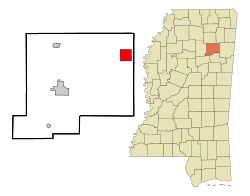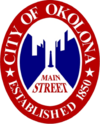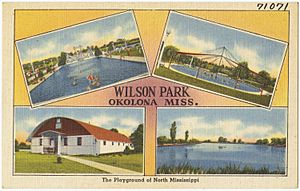Okolona, Mississippi facts for kids
Quick facts for kids
Okolona, Mississippi
|
|||
|---|---|---|---|
|
|||

Location of Okolona, Mississippi
|
|||
| Country | United States | ||
| State | Mississippi | ||
| County | Chickasaw | ||
| Area | |||
| • Total | 7.19 sq mi (18.63 km2) | ||
| • Land | 7.18 sq mi (18.59 km2) | ||
| • Water | 0.02 sq mi (0.04 km2) | ||
| Elevation | 338 ft (103 m) | ||
| Population
(2020)
|
|||
| • Total | 2,513 | ||
| • Density | 350.15/sq mi (135.18/km2) | ||
| Time zone | UTC-6 (Central (CST)) | ||
| • Summer (DST) | UTC-5 (CDT) | ||
| ZIP code |
38860
|
||
| Area code(s) | 662 | ||
| FIPS code | 28-53680 | ||
| GNIS feature ID | 0694253 | ||
Okolona is a city in Mississippi, United States. It is one of the two county seats of Chickasaw County. The city is located near the eastern edge of the county. In 2020, about 2,513 people lived there. Okolona was once known for its furniture industry and the Wilson Park resort.
Contents
Okolona's History
Okolona was first called Rose Hill when it was settled in 1845. However, people soon found out that another place already had this name. When a US post office opened here in 1850, a new name was needed. This was to make sure mail went to the right place.
According to the Okolona Area Chamber of Commerce, Colonel Josiah N. Walton helped choose the new name. He was the postmaster of nearby Aberdeen, Mississippi. He remembered meeting a Chickasaw warrior named Oka-laua. This name meant peaceful, yellow, or blue water. Walton renamed Rose Hill to Okolona to honor him. Another story says Okolona is a Native American name, possibly from the Choctaw language. It might mean "people gathered together."
Early Buildings and Farming
The American Civil War caused a lot of damage in the area. Because of this, not many buildings from before the war are still standing. The Elliott-Donaldson House, built in 1850, is one of the few that survived. It was added to the National Register of Historic Places in 1980. A few other old homes also remain.
In the mid-1800s, Okolona and the nearby Black Prairie became very important for farming. This area was sometimes called the "Bread Basket of the Confederacy". It was a major part of Mississippi's original Cotton Belt. This was even before the Delta region became famous for growing a lot of cotton.
The Mobile and Ohio Railroad finished its tracks through Okolona in 1859. This made the town a key place for processing cotton and sending it to markets. The town grew along Main Street because of the railroad. Most of the business buildings from this time, including the train station, were burned during the Civil War.
Civil War Battles
Five small battles or skirmishes happened in and around Okolona during the Civil War. The most famous one, the Battle of Okolona, took place in February 1864. This was a running fight between Confederate General Nathan Bedford Forrest and Union General William Sooy Smith. The Union forces were defeated just north and west of town. General Forrest's brother, Jeffery, was killed in this battle.
Okolona College
Okolona College was a special school for African Americans. It was a historically black college that operated from 1902 to 1965. Today, the college grounds are a central part of the Okolona College Historic District.
Geography of Okolona
According to the United States Census Bureau, Okolona covers about 18.63 square kilometers (7.19 square miles). Most of this area is land, with only a small part being water.
As new roads were built, they passed through Okolona. This helped connect the city to other towns. The city is where former U.S. Route 45 Alternate (Church Street) and Mississippi Highway 32 (Monroe Avenue) meet. Today, US-45A goes around the town to the east as a four-lane highway.
Population Changes
Okolona's population has changed over many years. Here is a look at how many people have lived in the city during different census years:
| Historical population | |||
|---|---|---|---|
| Census | Pop. | %± | |
| 1870 | 1,410 | — | |
| 1880 | 1,858 | 31.8% | |
| 1890 | 2,099 | 13.0% | |
| 1900 | 2,177 | 3.7% | |
| 1910 | 2,584 | 18.7% | |
| 1920 | 3,852 | 49.1% | |
| 1930 | 2,235 | −42.0% | |
| 1940 | 2,117 | −5.3% | |
| 1950 | 2,167 | 2.4% | |
| 1960 | 2,622 | 21.0% | |
| 1970 | 3,002 | 14.5% | |
| 1980 | 3,409 | 13.6% | |
| 1990 | 3,267 | −4.2% | |
| 2000 | 3,056 | −6.5% | |
| 2010 | 2,692 | −11.9% | |
| 2020 | 2,513 | −6.6% | |
| U.S. Decennial Census | |||
2020 Census Information
The 2020 United States Census showed that 2,513 people lived in Okolona. There were 1,164 households and 645 families. The population was made up of different groups:
| Race | Num. | Perc. |
|---|---|---|
| White | 490 | 19.5% |
| Black or African American | 1,922 | 76.48% |
| Native American | 3 | 0.12% |
| Asian | 3 | 0.12% |
| Other/Mixed | 64 | 2.55% |
| Hispanic or Latino | 31 | 1.23% |
Education in Okolona
The Okolona Municipal Separate School District serves the city. In 2010, the Mississippi State Board of Education decided to close the school district. Mike Vinson was put in charge of managing the district during this time.
Famous People from Okolona
Many notable people have come from Okolona, including:
- Thomas Abernethy, a former US Congressman.
- Tim Bowens, an NFL player who played for the Miami Dolphins for 10 seasons.
- Tom Bowens, a former professional basketball player.
- Meredith Gardner, a linguist and codebreaker.
- Jack Gregory, an NFL player and member of the Mississippi Sports Hall of Fame.
- William Raspberry, a well-known newspaper columnist.
- Milan Williams, a keyboardist and composer for the music group The Commodores.
- Delphia Welford, one of the oldest people ever from the United States.
See also
 In Spanish: Okolona (Misisipi) para niños
In Spanish: Okolona (Misisipi) para niños





